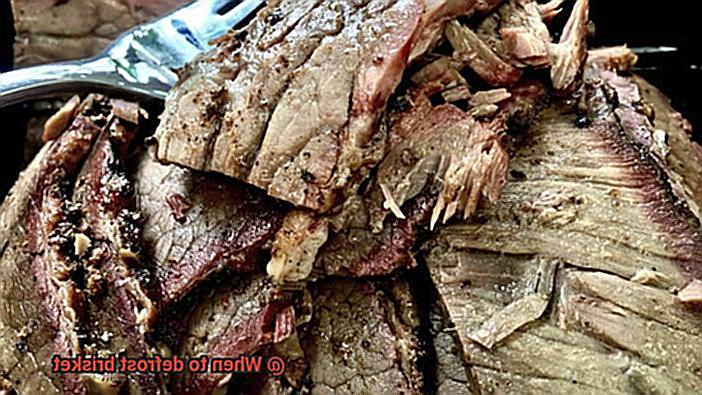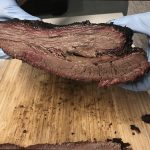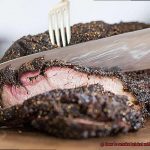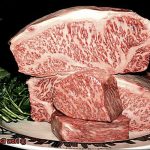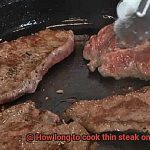Are you a meat enthusiast who craves the succulent and savory taste of brisket? If so, then you understand that cooking the perfect brisket requires some advanced preparation. One crucial aspect of creating a delicious brisket is defrosting it correctly. Without proper defrosting, your meat may not cook evenly, leading to an unappetizing undercooked or overcooked dish.
Defrosting meat is often an overlooked yet essential step in the cooking process. With brisket, it can be especially challenging due to its size and complex texture. Improperly defrosted brisket can spoil or ruin the cut of meat entirely.
So, when should you defrost your brisket? There are several options available depending on how much time you have before preparing your meal. In this post, we will cover different ways to defrost your brisket safely and effectively. We’ll also discuss proper food safety guidelines for handling defrosted meat.
Preparing to defrost your brisket requires patience, care, and attention to detail – much like any other culinary endeavor. Keep reading to learn everything you need to know about defrosting brisket so that you can create mouth-watering and unforgettable meals every time with confidence.
Contents
The Best Way to Defrost Brisket
Look no further. I am here to share with you the ultimate method for thawing your brisket to ensure maximum tenderness and taste.
First things first: avoid using quick methods such as hot water or the microwave. These methods can actually damage the texture of the meat and increase the risk of bacterial growth, leaving you with a less-than-perfect meal. Instead, take the time to defrost your brisket slowly and carefully in the refrigerator.
Think of your brisket as a precious gem that needs to be handled with care. Defrosting it too quickly could lead to a loss of flavor and texture. But when done correctly, you’ll be rewarded with a mouth-watering meal that’s sure to impress.
To defrost your brisket in the refrigerator, simply place it on a tray or dish and let it thaw slowly for 24-48 hours, depending on its size. This may take a bit longer, but trust me – it’s worth it. Your patience will be rewarded with juicy, tender meat that’s bursting with flavor.
When it comes to packaging, leave your brisket in its original packaging if possible. If not, wrap it tightly in plastic wrap or aluminum foil to retain as much moisture as possible. This will help ensure that your brisket stays as fresh and flavorful as possible.
In a pinch, you can use the cold water method. Simply place your brisket in a large bowl or sink filled with cold water and change the water every 30 minutes. Allow 30 minutes of defrosting time per pound of meat, and your brisket will be ready in no time. However, this method should only be used in emergencies, as it can impact the quality of the meat.
And once your brisket has been thawed, don’t forget to cook it within 1-2 days to ensure optimal freshness and safety. And whatever you do, never refreeze thawed meat – this can lead to further deterioration of its quality.
Allow Enough Time for the Brisket to Defrost
Before you start cooking, make sure to allow enough time for the brisket to defrost completely.
Picture your brisket as a delicate work of art that requires special care and attention. Hasty defrosting can leave you with a final product that is tough, dry, and lacking in taste.
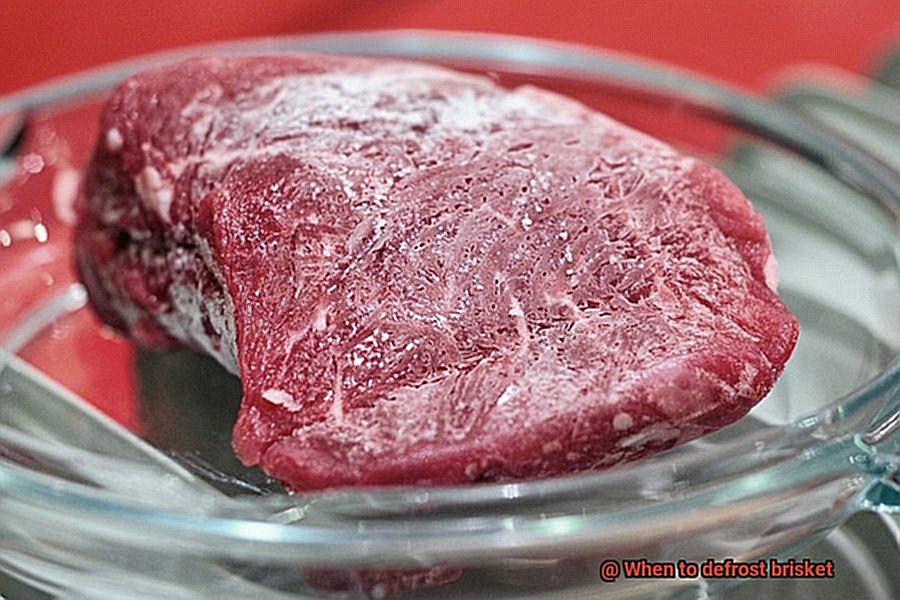
To attain the best results, plan ahead and let your brisket thaw in the refrigerator for at least 24 hours for every 5 pounds of meat. This gradual thawing method preserves the texture and juiciness of the meat.
If you’re short on time, you can use the cold water method as an alternate option. Just remember to change the water every half an hour until your meat is fully thawed.
Never be tempted to defrost your brisket at room temperature or in warm water. These methods can lead to bacterial growth, causing foodborne illness.
By taking the time to defrost your brisket properly, you’ll savor a mouth-watering final product that’s bursting with flavors and textures.
Keep the Brisket in its Original Packaging
Don’t worry, we’ve got you covered. Before you make any hasty decisions, let’s talk about why it’s important to keep the brisket in its original packaging during the defrosting process.
Your brisket’s packaging is specifically designed to protect it from freezer burn and contamination. By keeping it in its original packaging, you’re ensuring that it stays fresh and safe to eat. If you remove the brisket too soon, it can become dry and tough, which is a nightmare when you’re trying to impress your guests with your culinary skills.
The best way to defrost a brisket is by transferring it from the freezer to the refrigerator. Yes, this method may take some planning ahead, but trust us – it’s worth it in the end. For every 4-5 pounds of meat, give yourself at least 24 hours of defrosting time in the fridge. So if you have an 8-pound brisket, be sure to give yourself 2-3 days for defrosting.
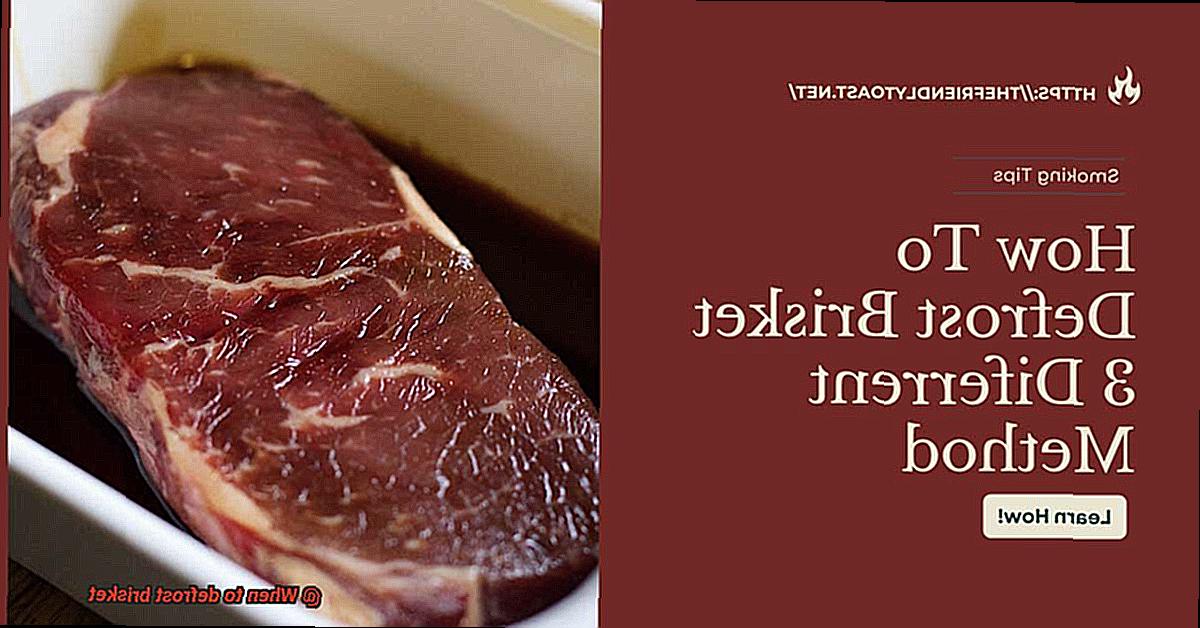
We know it can be tough to wait for that delicious brisket, but don’t be tempted to use hot water or a microwave to speed up the process. These methods can cause uneven thawing and dangerous bacteria growth. Plus, using hot water can affect the texture and flavor of the meat – and we definitely don’t want that.
To ensure your brisket is tender and flavorful when it’s time to cook, it’s crucial to keep it in its original packaging during the defrosting process. Remember: good things come to those who wait – and in this case, it’s a delicious brisket that will have your guests coming back for seconds (and maybe even thirds.).
The Cold Water Method
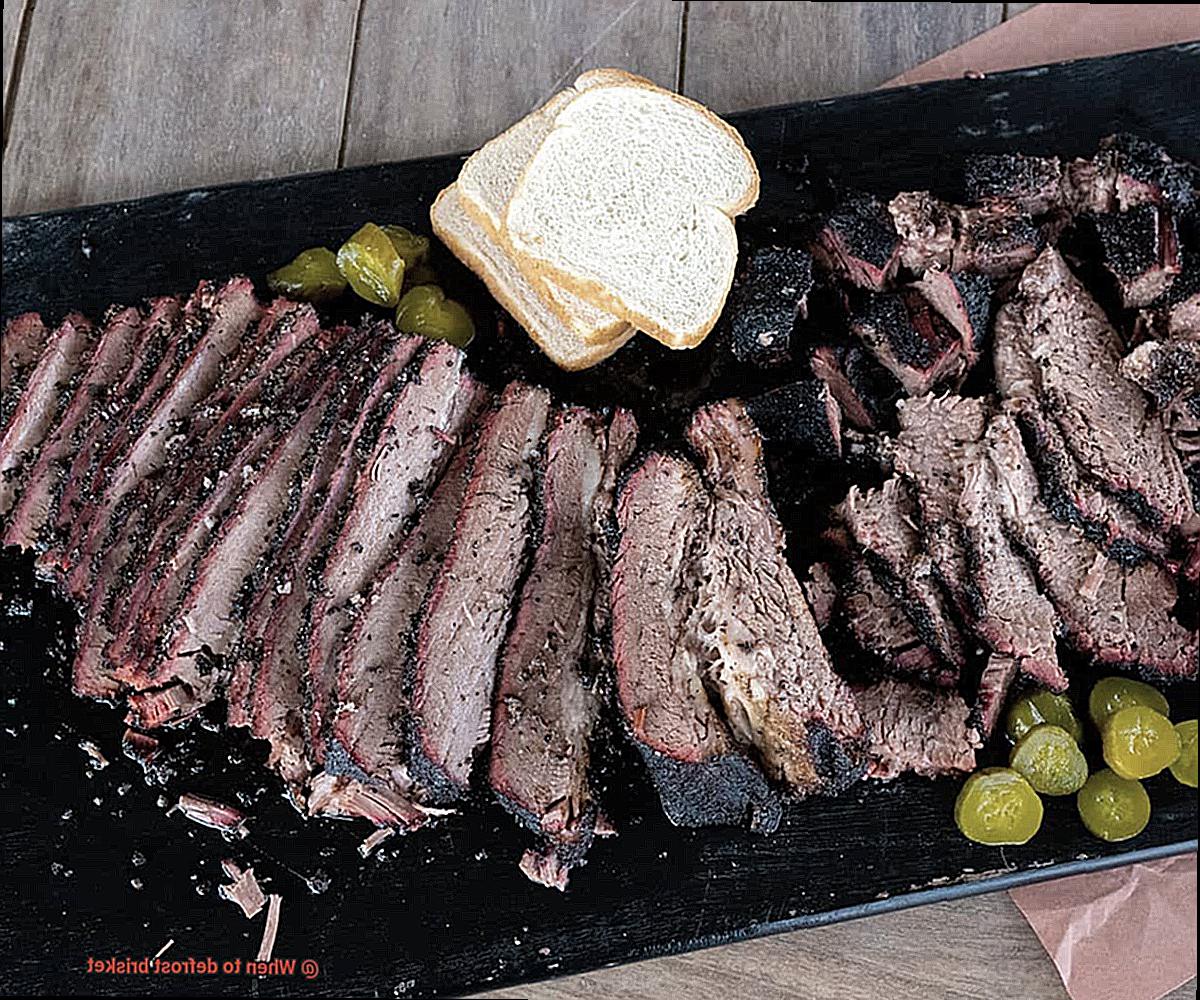
Fear not, because the Cold Water Method is here to save the day.
This defrosting method involves placing your frozen brisket in a leak-proof plastic bag and submerging it in cold water. It’s important to change the water every 30 minutes to prevent bacteria growth and ensure your meat stays at a safe temperature. Think of it like giving your brisket a refreshing dip in a cool pool on a hot summer day.
The time it takes to defrost your brisket using this method varies depending on its size and thickness. As a general rule of thumb, it takes about 30 minutes per pound of meat. That means if you have a 5-pound brisket, you’ll need to set aside around 2.5 hours to defrost it.
While the Cold Water Method may require more attention and effort than other methods, it’s an excellent option if you’re short on time or don’t have access to a microwave or refrigerator. Plus, it ensures that your meat stays safe and free from harmful bacteria.
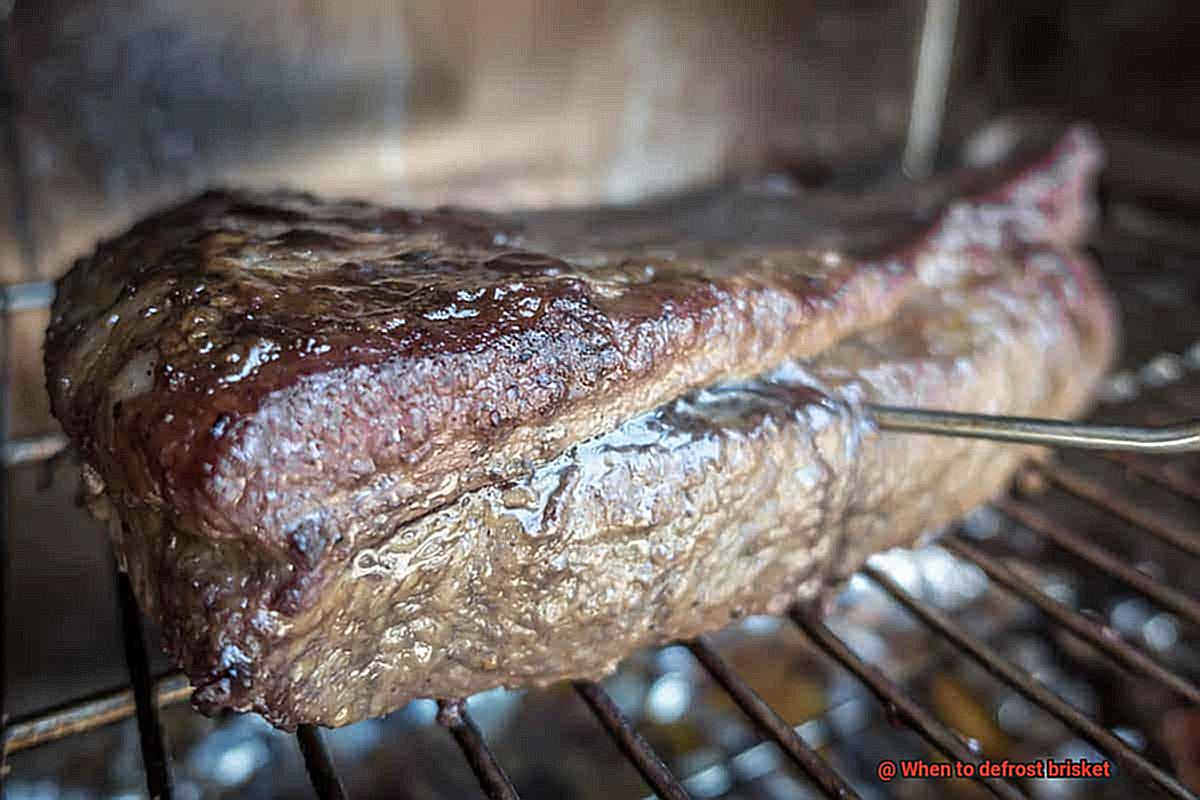
Remember to always follow food safety guidelines and keep a close eye on your brisket during the defrosting process.
Avoid Room Temperature and Hot Water
Before you get started, let’s talk about why using room temperature or hot water is a recipe for disaster.
Imagine this: you’re on a deserted island with a frozen brisket. You decide to thaw it in the sun. Sounds like a good idea? Think again. The heat of the sun can cause the brisket to defrost too quickly, providing a perfect breeding ground for harmful bacteria. Not appetizing.
Similarly, using hot water is like throwing your brisket into a boiling volcano. Okay, maybe that’s a bit dramatic, but you get the picture. Hot water causes the outer layer of the meat to defrost while the center remains frozen, creating an ideal environment for bacteria to thrive.
So what’s the best way to defrost your brisket? Enter the refrigerator and cold water methods – your new best friends. Think of the refrigerator as a cozy hotel room for your brisket. It may take longer to thaw, but it’s a safe and reliable option. Just be sure to place it on a plate or tray to prevent any drips from contaminating other foods.
If you’re pressed for time, the cold water method is here to save the day. Imagine taking your brisket for a refreshing dip in an icy pool – that’s what defrosting in cold water is like. Simply place your brisket in a leak-proof bag and submerge it in cold water. Change the water every 30 minutes until fully thawed. Remember, though – keep the water temperature below 40°F (4°C) to prevent bacterial growth.
In conclusion, avoiding room temperature and hot water when defrosting your brisket is crucial for food safety. Always use either the refrigerator or cold water methods and follow proper food handling procedures to ensure that your brisket is safe and delicious.
7GDBu8FmdpI” >
Conclusion
In conclusion, defrosting your brisket is an essential step in creating a delectable and succulent meal. To achieve even cooking and preserve the meat’s texture and taste, it’s crucial to defrost it correctly. Avoid rapid thawing techniques such as hot water or microwaving, which can impair the meat’s texture and increase the risk of bacterial growth.
The best way to defrost your brisket is slowly and carefully in the refrigerator. Although it may require some advance planning, you’ll be rewarded with a mouth-watering final product. If time is tight, you can use the cold water method, but ensure that you replace the water every 30 minutes to prevent bacteria growth.
Always keep your brisket in its original packaging if possible to shield it from freezer burn and contamination. Never be tempted to defrost at room temperature or in warm water as this can lead to bacterial growth causing foodborne illness.
Remember that preparing a perfect brisket requires patience, attention, and care for details. By following proper food safety guidelines for handling defrosted meat and allowing sufficient time for your brisket to thaw thoroughly, you’ll relish a final product bursting with flavors and textures.

